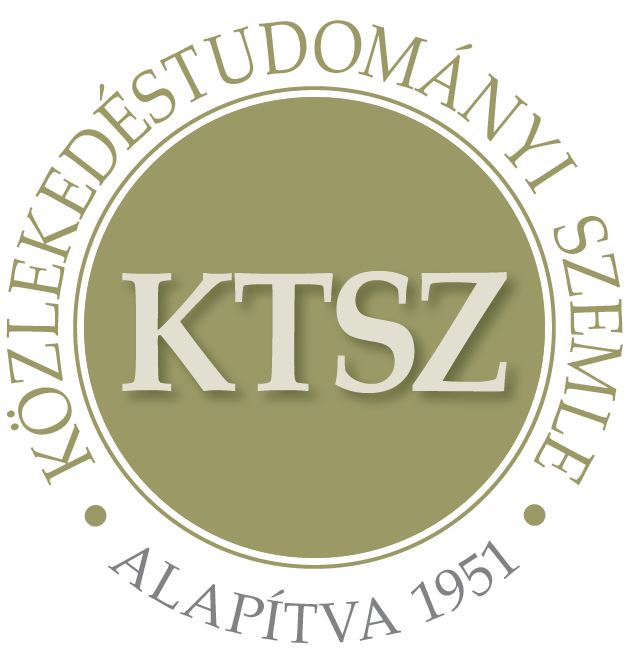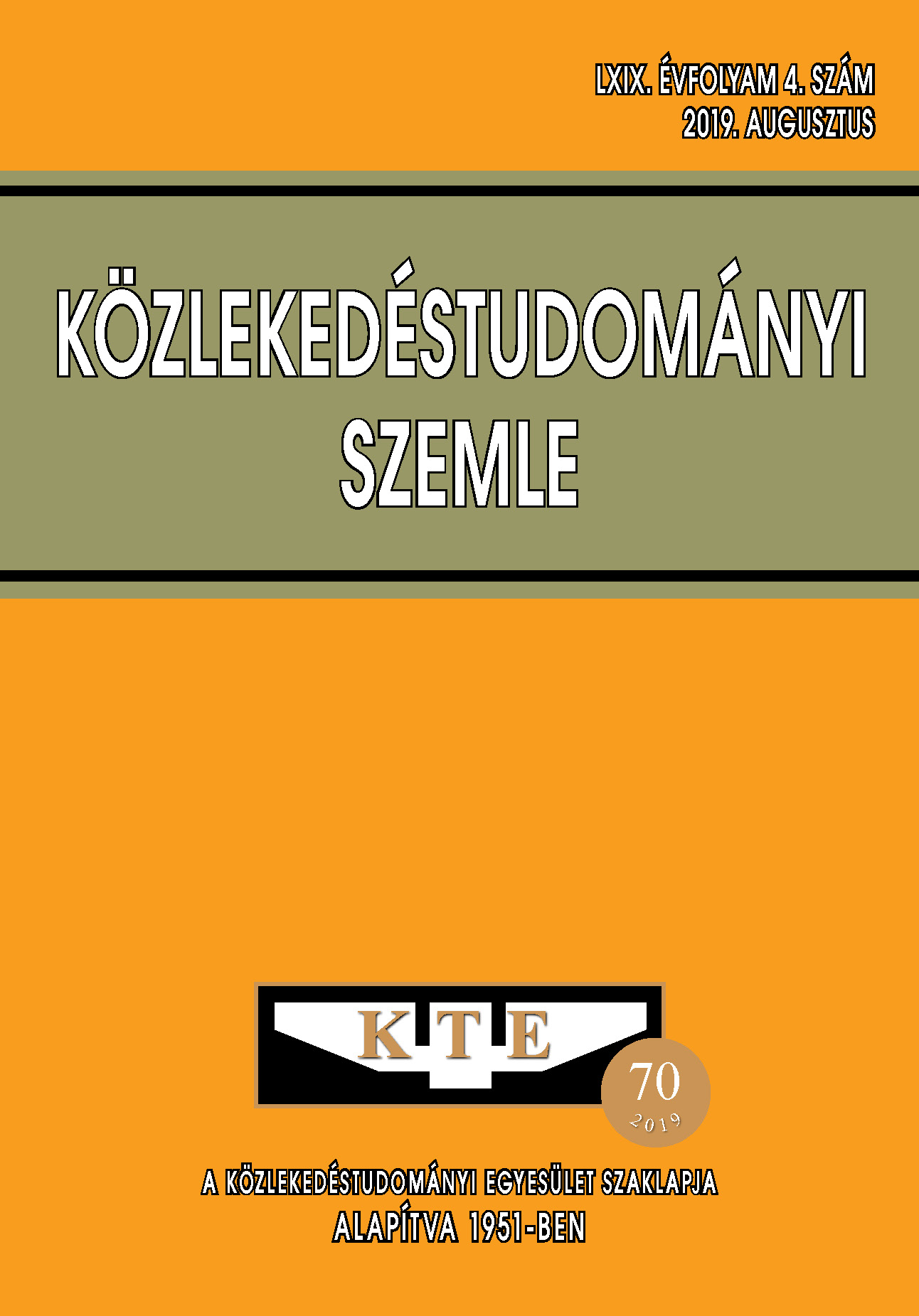A közösségi közlekedés helye és szerepe Európa városaiban (Városi vasút vagy autóbusz?)
Absztrakt
Mára a városi közlekedés már nem csupán a lakosság mobilitását hivatott szolgálni, hanem társadalmi-, gazdasági-, politikai-, kulturális és ökológiai szempontból is meghatározó tényező. Európában a városi lakosság részaránya folyamatosan nő, ami a gépjárműszám, illetve az ingaforgalom növekedésével jár és egyre súlyosabb közlekedési, környezeti problémákat okoz. Az elérhető, megbízható, megfizethető, biztonságos, kényelmes, fenntartható, környezet- és felhasználóbarát közlekedési szolgáltatások közvetett módon hozzájárulnak a városok élhetőségének javításához.
Hivatkozások
Budapest Közlekedésfejlesztési Stratégiája 2014-2030 – Balázs Mór Terv (2014)
Egységes Közlekedésfejlesztési Stratégia 2007-2020 – Fehér Könyv
Enyedi Gy. (1997.): A sikeres város, Tér és Társadalom, 11. évf. 1997/4. 1-7. p.
Hardi T.-Hajdú Z.-Mezei I. (2009.): Határok és városok a Kárpát-medencében, Győr – Pécs, 53-80. p.
Kazinczy L.: Az európai nagyvárosok regionális közlekedésének fejlődési irányai, Műszaki Szemle, Vol.4. No.13., 10-16.p.
Káposzta J. (2018.): A jó kormányzás regionális összefüggései a vidéki térben, Studia Mundi-Economica, Vol.5 No.3., 70-78.p.
Kisgyörgy L. (2014.): Utak, Budapest, Typotex Kiadó, 1.2 fejezet
Legát T. (2018): Közlekedik a Főváros, Budapest, Scolar kiadó, 11-38.p.
Mendöl T.(1963): Általános településföldrajz. Akadémiai Kiadó, Budapest, 520-570. p.
Nemecz G. (2018.): Városi kötöttpályás közlekedésfejlesztési projektek területfejlesztő hatásai, BKV Zrt., 36-54. p.
Nemes Nagy József (szerk): Regionális elemzési módszerek ELTE Regionális földrajzi Tanszék MTA_ELTE Regionális Tudományi Kutatócsoport Budapest 2005.
van Oort, N., van der Bijl, R., & Maartens, M. (2016): Waarde ov sterk onderschat. OVMagazine, In: Prawesh Brispat (2017): Perception based decision-making, Research regarding the added value of modality perception based analysis for public transport investments.
Pirisi G. – Trócsányi A. (2007.): A várossá nyilvánítás, mint a területfejlesztés eszköze?, Területfejlesztés és Innováció 2007/2. pp. 2-8.
Prileszky I- Fülöp G. – Horváth B.: Közúti üzemtan elektronikus jegyzet, Széchenyi István Egyetem, Győr, 2006.
Tóth T. (2018.): Gazdaságfejlesztési lehetőségek a jól működő településeken, Studia Mundi-Economica, Vol.5. No.1., 59-67.p.
Az Európai Parlament 2015. december 2-i állásfoglalása a fenntartható városi mobilitásról http://www.europarl.europa.eu/sides/getDoc.do?pubRef=-//EP//TEXT+TA+P8-TA-2015-0423+0+DOC+XML+V0//HU
EU Mobilitási és Közlekedési Főigazgatósága statisztikái, 2017. https://ec.europa.eu/transport/facts-fundings/scoreboard/compare/people/road-fatalities_en
Európai Számvevőszék: Az EU által támogatott városi tömegközlekedési projektek eredményessége (2014) https://www.eca.europa.eu/Lists/ECADocuments/SR14_01/QJAB14001HUC.pdf
Közlekedéstudományi Intézet adatbázisa http://www.kti.hu/trendek/kozlekedesimodok-kozepes-energiafelhasznalasa/
KSH Népességtudományi Kutatóintézet statisztikája http://demografia.hu/hu/tudastar/fogalomtar/84-varosi-lakossagaranya
KSH népszámlálási statisztika https://www.ksh.hu/docs/hun/eurostat_tablak/tabl/tps00001.html
McKinsey & Company: Elements of success: Urban transportation systems of 24 global cities (2018), https://www.mckinsey.com/~/media/McKinsey/Business%20Functions/Sustainability/Our%20Insights/Elements%20of%20success%20Urban%20transportation%20systems%20of%2024%20global%20cities/Urbantransportation-systems_e-versions.ashx
Nyíregyházi Egyetem: Közlekedési rendszerek jegyzet. http://www.nye.hu/ktit/sites/www.nye.hu.ktit/files/dokumentumok/E_segedletek/Kozlekrend/K%C3%B6zRendV%C3%A1z2017.pdf
Reális Zöldek Klub véleménye alapján http://realzoldek.hu/velemenyek/wpcontent/uploads/2012/09/2012-08-22-
NKS-SWOT-%C3%B6sszes%C3%ADtettanal%C3%ADzis01-ASz3+GG-MF1a.doc
Széchenyi István Egyetem: Közlekedéstan online jegyzet, 2002. https://ko.sze.hu/catdoc/list/cat/7086/id/7097/m/4974
Tolner László: Közlekedés és környezeti hatásai jegyzet. http://www.tolner.hu/okt/Iparkozl/IK17Kozlekedes.pdf
http://villamosok.hu/kepek/terkep/bp1915.gif
http://siteresources.worldbank.org/INTURBANTRANSPORT/Resources/chapter2.pdf
Az elektronikusan megjelenő cikkek nyílt hozzáféréssel rendelkeznek (OJS), online ingyenesen elérhetők és letölthetők. A cikkek szerzőit nem terheli megjelentetési vagy kiadási költség (APC). Felhasználóknak joguk van a cikkek olvasására, letöltésére, másolására, kinyomtatására, valamint azokban való keresésre, vagy a teljes szöveg linkkel történő megosztására.
A szerzőknek nyilatkozniuk kell arról, hogy beadványukat korábban nem tették közzé más folyóiratban, a pénzügyi támogatás feltüntetésre került és a hivatkozások listája teljes és pontos, beleértve az URL-ek és a DOI-k specifikációját is (ha rendelkezésre állnak). A cikktervezet beadásakor minden szerző jóváhagyja a benyújtott változatot. A szerzők garantálják, hogy a cikk az ő eredeti művük. A szerzők kötelesek részt venni a szakértői értékelés folyamatában, követni a bírálók tanácsait, betartani az előírt határidőket, és amennyiben előfordulnak, kötelesek visszavonni a benyújtást vagy kijavítani a hibákat.
Minden beadott cikket szakértői értékelés alá kerül, ahol a szerkesztők független értékelést kérnek legalább egy szakértőtől, ügyelve arra, hogy a bíráló(k)nak ne legyen összeférhetetlensége a szerzőkkel. A végső döntést a főszerkesztő hozza meg, aki figyelembe veszi az értékeléseket és a szerkesztők javaslatait. A szerkesztők és a lektorok bizalmasan kezelik a beadványt.
A kiadó és a szerkesztők elkötelezettek a magas etikai normák betartása mellett, és megakadályozzák azokat a publikációkat, amelyekben kutatási visszaélés történt. Az ilyen etikai kérdésekben a COPE irányelveit követik.
A szerzők fenntartják a szerzői jogokat, és megadják a folyóiratnak az első közzétételi jogot a Creative Commons Licenc alapján (https://creativecommons.org/licenses/by-nc-nd/4.0), amely lehetővé teszi mások számára, hogy megosszák a művet, elismerve a mű szerzőségét és a folyóiratban való első közzétételt.
A folyóirat archiválja az összes megjelent cikket, és a folyóirat tulajdonosa, a Közlekedéstudományi Egyesület továbbra is üzemelteti az adatbázist abban az esetben is, ha a folyóirat kiadása megszűnik.















